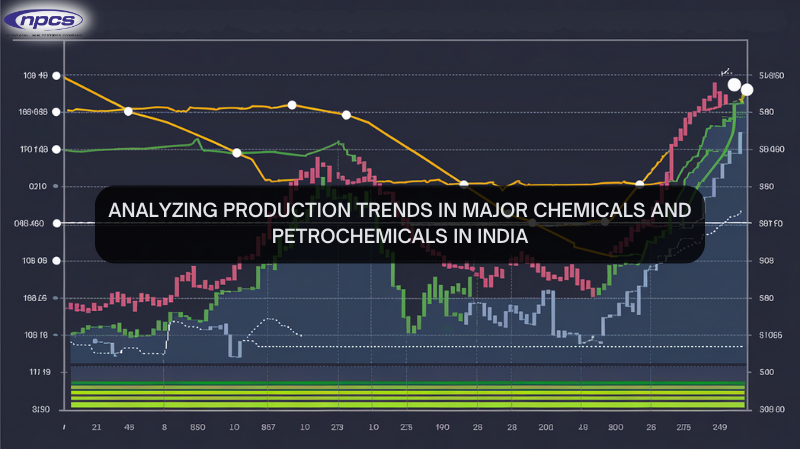The factors mentioned above bring forth the importance of the chemical and petrochemical industry to the industrialization of any nation. As the tide goes, this specific industry has to witness great expansion, thanks to the rising consumption within the country, the various government bodies, and technological innovations. A production trends study conducted on the chemicals and petrochemicals industry in India over the years is given here in this report where the performance, its drivers of growth, and the outlook are discussed in detail.
Overall Production Growth
The development of the chemical and petrochemical industry in India has been steady without a doubt and it has been instrumental to the national economy. As per recently available information, India’s total production of major chemicals and petrochemicals reached 26,570 thousand metric tonnes during the first half of the financial year 2022-23 (till September 2022). The CAGR of Overall chemicals and petrochemicals from 2017-18 to 2021-22 stood at 4.61%, which indicates the steady growth of the industry.
India’s present-day trend of cementing its position as one of the leaders in the chemicals and petrochemicals area on global scale is aided by growing domestic consumption, increasing volumetric exports, and greater attention to green practices within manufacturing. In addition, the government’s focus on improving ‘self-reliance’ in domestic production and the initiative to promote ‘Make in India’ had also significantly boosted production in this sector.
Join With Us
Chemical Sector Trends
The verticals of the Indian economy are presented by chemical production, which has always been a decisive driving force for the country. Major chemicals production possessed a figure of 6487 thousand metric tonnes in the FY 2022-23 (April to September 2022). From the fiscal year 2017-18 to the fiscal year 2021-22, the CAGR of total major chemicals production registered at 3.58%, which indicates a low growth but continuous growth pattern.
However, some key segments of the chemical industries have performed well during this span:
- Alkali Chemicals: This is the biggest segment in the chemical industries and achieved a CAGR growth of 4.33% for the years 2017-18 to 2021-22 in the production of alkali chemicals. Textile, glass, and soap industries use alkali chemicals extensively in pulverization, which has increased their production due to the rising demand for these industries.
- Organic Chemicals: Industrial organic chemicals include those which are used as intermediates. This segment, however, experienced growth as it had a CAGR of 2.08% during this period. Several end uses incorporate organic chemicals, including, for instance, medicine, works made out of plastics, and engineered materials.
- Pesticides: The production of pesticides, an important product for the agriculture sector, grew fast with 8.92% CAGR from 2017-18 to 2021-22. Such heightened increase is mainly because of expanding agricultural practices in India agri-base and the pressure to raise agricultural productivity in the country owing to the increase in population.
- Dyes and Pigments: Dyes and pigments used by industries such as textiles and paint registered a CAGR of 2.03% for the period under consideration. The relatively low performance in this sector could be as a result of high fluctuation of prices of raw materials and globally, a trend towards using safer alternatives.
Petrochemical Sector Trends
In contrast to the chemical industry, the petrochemical industry in India has demonstrated better growth. The capacity production of key petrochemicals over the last year (for the financial year 2022-23, up to September 2022) was 20,083 thousand tonnes metric. With a recorded CAGR of 4.91% between 2017-18 and 2021-22, it has been one of the core and demanding sectors in the industry that is growing very fast.
Some of the factors boosting the growth in the petrochemical sector include the growing consumption of plastics and synthetic materials, as well as the other products of this technology used in different industries. Some important sub sectors of the petrochemical industry are as follows:
Synthetic Fibers
The synthetic fibers which textile industries generally use had a CAGR of about 2.75% for the duration from 2017-18 to 2021-22. In India, the growing demands in the fashion and textile sectors have driven the use of synthetic fibers; however, issues concerning sustainability might restrain future growth.
Polymers
Widely used in every sector, polymers also experienced a robust growth during this time with a CAGR of 7.68%. This entire increase in the target market has been backed by the rise in demand for plastic, plastic household goods and plastic packaging.
Synthetic Rubber
The automotive grade synthetic rubber production expansion rate ranged around purchasing power parity growth rate of 5.60 percent over the past 5 years. This development in this segment is connected to the automotive industry in India which is also the second largest market for automobiles in the world.
Olefins
Olefins, the chemical intermediates utilized in many processing industries, registered a CAGR of 8.58%, thus being among the high growth areas of the petrochemical industry. High growth rate indicates fast growth of the sector due to high level of backwards integration with the sector.
Aromatic compounds
While the production of aromatics has recorded significant growth, this category has seen negative growth with a negative CAGR of -3.25%. Since their end uses include consumer products like paints or even detergents, and considering their consumption patterns, one can find plausible reasons for their inverted production because of demand variability in the market and also due to possible substitutes for the products.
Industrial Production Index
The Index of Industrial Production (IIP), which assesses performance of certain industrial verticals, is equally significant in determining the health of this sector. The IIP index for chemicals and chemical products registered annual growth, reaching 132.3 in September 2022 compared to 124.3 at the same time last year. The Index for the sector registered a high of 137.2 in July 2022, showcasing the sector’s perfect performance of late.
Start a Business in Chemical Industry Projects, Click Here
Government Initiatives and Investments
In order to increase the production and to bring in investments, the Indian government has launched a number of schemes which seek to improve the chemical and petrochemical industry in the country. Important programs in this direction include the establishment of Petroleum, Chemicals and Petrochemicals Investment Regions (PCPIRs) and development of Plastic Parks. They focus on building state-of-the-art facilities, attracting overseas investments and increasing the local production capacity.
Glimpses of the government’s pursuance towards developing processes which are less harmful to the environment can also be seen. Initiatives like the Green Chemistry Initiative encourage waste reduction, utilization of biodegradable raw materials and lessen effluent discharges from chemical plants. These projects follow from worldwide tendencies towards cleaner and greener industries.
Challenges and Outlook
In spite of the encouraging performance of the sector, some issues still remain. Risks remain on the due course of growth on factors like the instability of raw material prices, challenges in the supply chain, and risks emanating from the global economy. Furthermore, the sector has to grapple with tougher environmental policies and the transition to green manufacturing concepts
The outlook for the Indian chemical and petrochemical market continues to be optimistic. The favorable demand from local consumption, consistent infrastructure development, and assistance from the government makes the sector ready for growth. In addition, increased focus on value-added products and downstream integration will help boost India’s stature in this sector even more.
Conclusion
India’s chemical and petrochemical industry plays a central role towards the character and expansion of industries and economy in the country. The industry has experienced a compound annual growth rate exceeding 4.6% in the last few years, which shows its stability and potential for growth. The petrochemical products performing better than the basic chemicals hints at higher levels of downstream integration and value addition. The chemicals and the petrochemicals industries are important as India strives to establish itself as a global manufacturing center in the near future. Manufacturers will have to address challenges associated with raw material availability and environmental issues to ensure sustainability of the growth.






